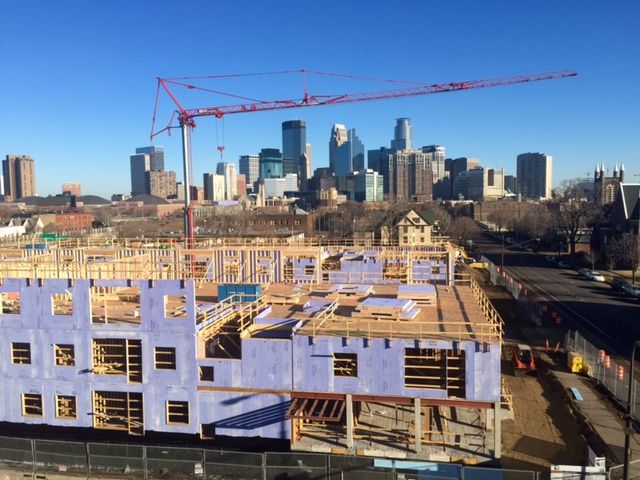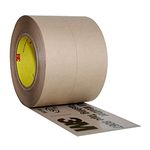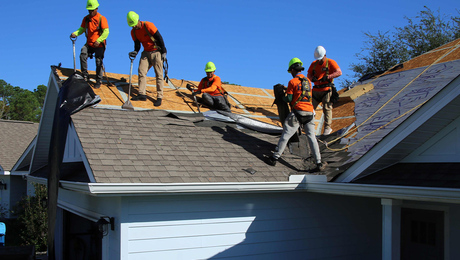
With a couple of successful LEED projects behind it, the Minneapolis affordable-housing developer Aeon began looking for a more aggressive sustainable-building program, one that would pay much bigger energy dividends for its tenants over time. For all of its advantages, LEED just wasn’t enough.
Aeon settled on the Living Building Challenge to guide construction of its 90-unit apartment building in south Minneapolis, recognizing right from the start there was no way the project would win full certification. But the $36.5 million project called The Rose, now under construction, should come in at about $148 per sq. ft. and offer energy and other benefits not typically associated with affordable housing.
“I’m not bashing LEED,” said Aeon’s vice president of housing development Gina Ciganik in a recent phone interview. “I think LEED has brought us tremendously far and has gotten word out to the masses, so I think it’s been helpful incrementally in getting more and more people used to it.”
But when the developer did the math, the energy savings of 30% or so it expected to see on LEED-certified buildings didn’t offer enough long-term savings to low-income residents.
Even making conservative assumptions about how much building it would do, and factoring in a modest 2% rise in energy costs, Ciganik said residents living in Aeon’s portfolio of projects would be paying a total of $130 million for utilities over the next 20 years.
“When I saw that number I thought, ‘That’s staggering.’ That’s staggering to be known as a pretty darn green developer and there’s $130 million,” she said. “That’s a huge number. And if we’re trying to keep these units affordable, both in terms of their rents and maintaining the property, and we want our residents to have lower energy bills and water bills, we better figure this out.”
Looking at green building with a “wide lens”
The Living Building Challenge, developed in 2006 by architect Jason McLennan, includes seven areas of compliance, called “petals,” that require, among other things, net-positive energy and water, the use of non-toxic materials that can be sourced on a sustainable basis, and a healthy interior environment. There is even a “beauty & inspiration” petal.
“It views green building through a wide lens that includes the inhabitants of the built environment and takes into account the upstream and downstream impacts of modern building materials,” its website says.
It wouldn’t seem to be very fertile ground for an affordable housing apartment building on a lean budget, but that’s where Aeon ended up.
Ciganik said the project will be seeking partial certification–that is, for some but not all program petals.
For example, The Rose won’t be net-positive energy. Even with all available roof space covered with photovoltaic (PV) panels, there would be only enough electricity to power about a third of the apartments in the project. By waiting several years, Ciganik hopes Aeon will see improvements in PV efficiency that would provide a better return on the investment.
The developer also has decided to skip some of the water-conservation requirements. There isn’t enough rainfall locally to meet the needs of 90 housing units, she said. The upfront cost of building a waste treatment plant for The Rose, apparently another requirement, would have been $2 million, with another $250,000 a year in operation and maintenance costs.
Still, the project will include enough features to reduce daily water consumption from an average of 70 gal. per person to between 30 and 35 gal., she said. Rain gardens will help control runoff, and storm-water retention will provide water for the 5000 sq. ft. of community gardens.
According to an article about the project at Finance-Commerce.com, The Rose will include 43 units to be rented at the market rate, 35 as affordable housing and 12 for people who had been homeless.
Big projects are special challenges
One of the biggest hurdles to get over was figuring out how to apply the Living Building Challenge to a large building, something over 150,000 sq. ft.
“There have been some phenomenal projects that have been certified,” she said, “or have gotten some of the petals, but when you look at them, they have been very small buildings. It’s hard to translate success to the larger, super-dense buildings where people are living 24/7, 365 days a year.”
She said many of the successful projects are commercial, single-family or “boutique single user” offices, nature centers, or day care facilities in the range of 3000 to 10,000 sq. ft. The Bullitt Center in Seattle, perhaps the best known Living Building Challenge-certified structure in the country, is about 50,000 sq. ft.
Energy and water use is much easier to control in, for example, an office setting where the boss can instruct people to shut off their computers at the end of the day and no one is washing clothes or taking showers. In an apartment, Ciganik says, you can’t order someone to limit showers to 10 minutes.
As far as she knows, The Rose is the only multifamily affordable housing project seeking certification from the program.
Finding nontoxic materials isn’t always possible
Another stumbling block is finding building materials that don’t contain any toxic components, the chemicals showing up on the Living Building Challenge “Red List.” The list doesn’t include generic or trade names, just the chemical compounds that designers should avoid.
“It’s the materials petal that really takes the wind out of your sails,” Ciganik said. “The availability is challenging. Getting manufacturers to disclose is nearly impossible, and then when you do have products many of them have a premium you can’t afford, or they’re new enough that you’re not sure you want to pay the premium because you don’t know if they’ll be durable.”
Technically, the building should not contain any products made from polyvinyl chloride, for example, a staple of modern construction. The deeper designers dug, the more they learned about the kinds of products that are commonly used in building.
“It was shocking to me the more I learned about what we’re breathing in and what we’re doing to ourselves,” Ciganik said. “Decades from now, I think future generations will look back on us kind of like we look at people who put leeches on themselves for medical reasons.”
The Living Building Challenge does grant exceptions. Eric Corey Freed, its vice president for global outreach, said that when the Red List and building codes are at odds, the building codes take precedence. For example, ABS plumbing pipe is required by certain codes but also included on the list. It wouldn’t be fair, he said, to force builders to avoid something that is specifically required by code.
Energy performance goals
Aeon projects energy use will be about 75% less than a similar building that must meets Minnesota’s state building code.
Ciganik said the Energy Use Intensity (EUI) of a code-complaint building is about 100 (EUI is calculated by dividing the total energy used in a year by the building’s gross floor area). The LEED-certified buildings that Aeon had developed have an EUI in the range of 55 to 70, while The Rose has a modeled EUI of 28, which would equate to 28,000 Btu per sq. ft. per year.
But unlike the Passivhaus standard, which sets specific limits on the amount of energy consumed in the building, the Living Building Challenge lets builders find the best way to net-positive energy without dictating how it is done or how much total energy is used.
“No,” Freed said, “it’s not a prescriptive model, that you must have R-19 in the walls or anything like that. It leaves it up to the project team to figure out the best approach. What we’ve seen among all the projects is there’s super energy efficiency because they want to get the base load down as much as possible and that minimizes the size of the solar array of the wind turbine or whatever they put in.”
Nor does the Living Building Challenge require any specific level of airtightness in the building. That, too, is left to the builder’s discretion.
Specs provided by Bill Weber, a senior research fellow at the University of Minnesota Center for Sustainable Building Research and a member of the team that helped develop plans for The Rose, include:
- Exterior walls: Framed with 2×6 and insulated with spray foam, insulated to R-40 on the ground floor and to R-31.5 on the upper floors.
- Roof: Insulated with cellulose to R-80.
- Windows: Double-glazed, foam-filled frames with a whole-unit U-value of 0.28. The solar heat gain coefficient is 0.25. Project manager Rhys MacPherson says windows make up 23% of the envelope, the “sweet spot position and wall envelope performance.”
- Foundation: Foundation walls (which form a sub-grade garage) and slab insulated with rigid foam to R-10.
- Domestic hot water: Kingspan Thermomax DF100 evacuated tube solar collectors totaling 800 sq. ft. on the south side of the building’s elevator towers (for an estimated 34% of domestic hot water needs) plus gas-fired condensing boilers to provide the balance.
- Heating and cooling: Mitsubishi RD zoned air-source heat pumps.
- Ventilation: Bathroom exhaust fans routed to a dedicated outdoor air system (DOAS). Kitchen exhaust fans are vented at the roof. According to the architect, the ventilation rate is double that required by code to ensure high indoor air quality.
Numbers are small but growing
Since the Living Building Challenge program was launched nine years ago, 21 buildings have been certified, only six of them reaching full certification and the balance meeting requirements for a partial certification. Another five will be announced at the organization’s conference on April 1, two of those full certifications.
That’s a rate of less than one fully certified building per year.
“That’s because it’s a challenge, right?” Freed said. “But here’s the interesting angle to the story. When it came out nine years ago, everybody said, ‘It’s impossible. Nobody will be able to do that.’ And now we’ve proved them wrong, and what ‘s really amazing is not the 21, and what will soon be 26 when we announce the other five, but the 250 in queue that are working toward it.
“Obviously, not all of them will probably go all the way,” he continued, “but they’ve registered for it, and a lot will. So we’re seeing this sort of groundswell of activity. There’s this kind of an impending tidal wave of new certifications that will be coming out in the next year.”
Fine Homebuilding Recommended Products
Fine Homebuilding receives a commission for items purchased through links on this site, including Amazon Associates and other affiliate advertising programs.

Handy Heat Gun

8067 All-Weather Flashing Tape

Affordable IR Camera

Developers in Minneapolis are building a 90-unit multifamily project they hope will qualify for parts of the Living Building Challenge, a rigorous building standard that currently has less than two-dozen certified projects on the books.






















